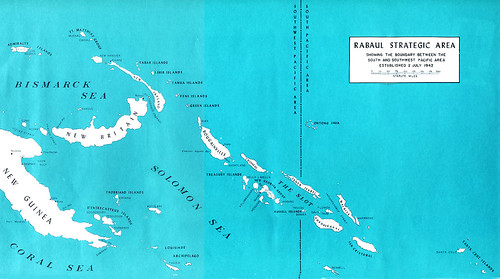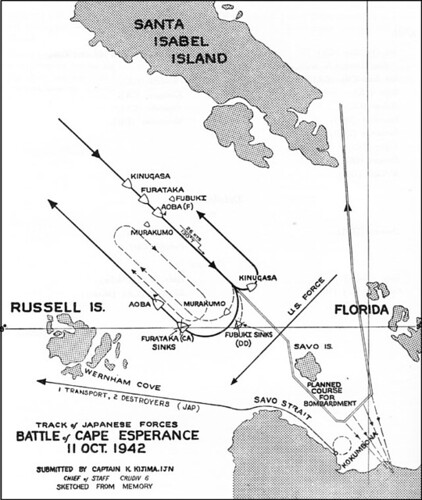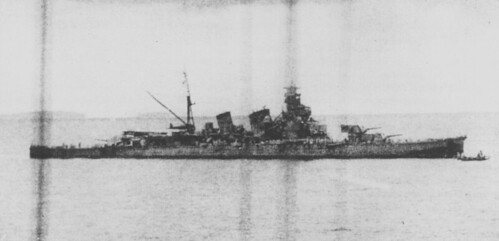The night action of 10-11 OCT, sometimes know as the Second Battle of Savo Island - but usually as The Battle of Cape Esperance, is an excellent example of the critical importance of training, flexibility, initiative, and aggression - combined with a measure of luck. Luck is always essential, as even the most simple plans become complicated once the battle begins.
First background.

Remember, this is still the "go to war with the Navy you have" part of the war, as the entire Solomon Islands Campaign was.
DIVISION 6 of the Imperial Japanese Navy was pretty pleased with itself following its engagement with the Americans off Savo the night of August 8-9, and perhaps with reason. The Japanese felt that they had won a victory, greater than their usual "victories," and although the loss of the KAKO outside the harbor of Kavieng following the battle had cut into their forces by a quarter, they felt themselves to be the backbone of Japan in the Solomons.
But the Americans still clung tenaciously to their ground in the Guadalcanal and Florida islands despite air raids and night bombardments from the "Tokyo Express. " And although their position was precarious, it wasn't enough so for the Jap.
If the Japanese headquarters on Rabaul was busy with plans for marshaling their strength for a knockdown battle for the Solomons, so were the Americans at Espiritu Santo. Something had to be done to stop the Japanese from reinforcing their troops, and from storming Marine positions from the sea, and obviously one way to do it was to reinforce our own land forces at Guadalcanal. For this, a large convoy with Army reinforcements for Guadalcanal was soon to depart from Noumea, in French New Caledonia, halfway between Fiji and Australia. By October 1 1 it would be about 250 miles west of Espiritu Santo, protected by two task forces: one built around the carrier HORNET, the other around the new battleship WASHINGTON.
In Espiritu was a newly organized task force. Its ships had engaged only in target practice together but they were good ships. It would do well, as protection for the left flank of the Army convoy approaching Guadalcanal, to station this task force off the southern shore of that island to intercept any enemy units moving in from the west.

Remember, this is still the "go to war with the Navy you have" part of the war, as the entire Solomon Islands Campaign was.
The post Midway march to Tokyo was on, but this was only the beginning of the beginning.
Let's look at the lineup.
USN:
TF 64
Rear-Admiral Norman C. Scott
Bombardment Group
Rear-Admiral Goto
Let's look at the lineup.
USN:
TF 64
Rear-Admiral Norman C. Scott
- USS SAN FRANCISCO (CA-38)
- USS BOISE (CL-47)
- USS SALT LAKE CITY (CA-25 )
- USS HELENA (CL-50)
- USS FARENHOLT (DD-491)
- USS DUNCAN (DD-485)
- USS LAFFEY (DD-459)
- USS BUCHANAN (DD-484)
- USS MCCALLA (DD-488)
Bombardment Group
Rear-Admiral Goto
And so, off they went.
Departing New Caledonia on October 8, ships carrying the US 164th Infantry moved north towards Guadalcanal. To screen this convoy, Vice Admiral Robert Ghormley assigned Task Force 64 ... to operate near the island. ... Initially taking station off Rennell Island, Hall moved north on the 11th after receiving reports that Japanese ships had been sited in The Slot.MicroWorks calls this "Stumbling into Victory." That is one way to look at it.
Me? I call it a lesson on the need for trusting your Commanding Officers with short, direct orders. As an editorial note for brevity, there are two IJN groups NW of Guadalcanal, Goto's Bombardment Group and RADM Jojima's landing force with 4,500 troops.
As he moved north, Hall, aware that the Americans had faired badly in previous night battles with the Japanese, crafted a simple battle plan. Ordering his ships to form a column with destroyers at the head and rear, he instructed them to illuminate any targets with their searchlights so that the cruisers could fire accurately. Hall also informed his captains that they were open fire when the enemy was sited rather than waiting for orders.But ahhhh, one man's brevity code is another's order.
Approaching Cape Hunter on the northwest corner of Guadalcanal, Hall, flying his flag from San Francisco, ordered his cruisers to launch their float planes at 10:00 PM. An hour later, San Francisco's float plane sighted Jojima's force off of Guadalcanal. Expecting more Japanese ships to be sighted, Hall maintained his course northeast, passing to the west of Savo Island. Reversing course at 11:30, some confusion led to the three lead destroyers (Farenholt, Duncan, and Laffey) being out of position. About this time, Goto's ships began appearing on the American radars.
Initially believing these contacts to be the out of position destroyers, Hall took no action. As Farenholt and Laffey accelerated to reassume their proper positions, Duncan moved to attack the approaching Japanese ships.
A mere 5000 yards distant Goto's ships were moving directly into the center of the American line, which Goto, deeply feeling that no American was present, considered to be Joshima's reinforcement group. It was up to Helena to teach him otherwise. Captain Hoover was certain he had the enemy before him and queried Scott to open fire. Scott replied, "Roger", which he intended as a confirmation of receipt, but if unqualified it meant open fire as well, and Hoover interpreted it as such. He switched on his searchlights, aiming them on Hatsuyuki, the left-wing destroyer, and opened fire with his fifteen 155mm guns at 2346.
Another account describes this classic thus;
That action caught Scott off-guard, but he did not prevent the rest of his line from opening fire on the enemy. Duncan, now only a few hundred yards from Kinugasa, joined in, but was quickly disabled.
At 11:45, Goto's ships were visible to the American lookouts and Helena radioed asking permission to open fire using the general procedure request, "Interrogatory Roger" (meaning "are we clear to act"). Hall responded in the affirmative, and his surprise the entire American line opened fire. Aboard his flagship, Aoba, Goto was taken by complete surprise.Let's talk about VADM Goto for a second. In a battle that lasted only 30 minutes, the first few were an all-American show. Why? Well, confusion and an inability to realize that your plan was no longer going to happen and that all you were told was wrong. The enemy always gets a vote.
Gotō's force was taken almost completely by surprise. At 23:43 Aoba's lookouts sighted Scott's force, but Gotō assumed that they were Jojima's ships. Two minutes later, Aoba's lookouts identified the ships as American, but Gotō remained skeptical and directed his ships to flash identification signals. As Aoba's crew executed Gotō's order, the first American salvo smashed into Aoba's superstructure. Aoba was quickly hit by up to 40 shells from Helena, Salt Lake City, San Francisco, Farenholt, and Laffey. The shell hits heavily damaged Aoba's communications systems and demolished two of her main gun turrets as well as her main gun director. Several large-caliber projectiles passed through Aoba's flag bridge without exploding, but the force of their passage killed many men and mortally wounded Gotō.CAPT Kijuma, VADM Goto's Chief of Staff stated,
"At first we thought the fire was from our own supply ships. It was a surprise attack. All ships but the KINUGASA immediately reversed course to the right. Due to the shellfire and the congestion, the KINUGASA turned left. As a result ofChaos, on both sides.
this turn the KINUGASA only received minor damage from three hits. The AOBA was hit about forty times and was badly damaged. The FURUTAKA and FUBUKI were sunk. The FUBUKI sank before it completed the turn, although it only received four hits. Due to the smoke from the AOBA, the MURAKUMO was not hit. The KINUGASA did most of the fighting for our force.
"Soon after the action started Admiral Goto was mortally wounded. While he was dying, I told him that he could die with easy mind because we had sunk two of your heavy cruisers.
"Following this action we retired to the northwest. The MURAKUMO turned back and rescued about four hundred survivors. When your forces reappeared it departed the area trying to make you chase it within range of our aircraft."
Over the next few minutes, Aoba was hit more than 40 times by Helena, Salt Lake City, San Francisco, Farenholt, and Laffey. Burning, with many of its guns out of action and Goto dead, Aoba turned to disengage. At 11:47, concerned that he was firing on his own ships, Hall ordered a ceasefire and asked his destroyers to confirm their positions. This done, the American ships resumed firing at 11:51 and pummeled the cruiser Furutaka. Burning from a hit to its torpedo tubes, Furutaka lost power after taking a torpedo from Buchanan. While the cruiser was burning, the Americans shifted their fire to the destroyer Fubuki sinking it.Two minutes of firing - four minutes of "where and the h311 is everyone" and then firing again. That 4 minutes must have seemed like an hour.
As the battle raged, the cruiser Kinugasa and destoryer Hatsuyuki turned away and missed the brunt of the American attack. Pursuing the fleeing Japanese ships, Boise was nearly hit by torpedoes from Kinugasa at 12:06 AM. Turning on their search lights to illuminate the Japanese cruiser, Boise and Salt Lake City immediately took fire, with the former taking a hit to its magazine. At 12:20, with the Japanese retreating and his ships disorganized, Hall broke off the action.The end result of the battle was a complete smacking. Losses:
Later that night, Furutaka sank as result of battle damage, and Duncan was lost to raging fires. Learning of the bombardment force's crisis, Jojima detached four destroyers to its aid after disembarking his troops. The next day, two of these, Murakumo and Shirayuki, were sunk by aircraft from Henderson Field.
USN:
This battle was the happy middle between two sobering hammers - The Battle of Savo Island for one, and two months later Tassafaronga. In the end, I think this best catches the results, .
.
- 1 destroyer sunk,
- 1 cruiser,
- 1 destroyer heavily damaged,
- 163 killed
- 1 cruiser,
- 3 destroyers sunk,
- 1 cruiser heavily damaged,
- 341–454 killed,
- 111 captured
This battle was the happy middle between two sobering hammers - The Battle of Savo Island for one, and two months later Tassafaronga. In the end, I think this best catches the results,
A junior officer on Helena later wrote, "Cape Esperance was a three-sided battle in which chance was the major winner."A great take-away would be this quote that could be heard after any sea battle for the last 2,500 years, I bet.
In the words of one petty officer who was overheard talking with another on the way back to Espiritu Santo, "I'll never complain of another drill, and I'll deck the man who does."BTW, that quote and a few others come from Battle Report: Pacific War: Middle Phase by CDR Walter Purdon, USN and CAPT Eric Karig, USN which you can get for free online here, or get the 1947 hardback original here
This will be crossposted at USNIBlog as part of the SJS led Solomon Islands Campaign thread.











No comments:
Post a Comment